L'Or Vert de Ceylan : À la découverte des trésors du thé de Nuwara Eliya
Des collines émeraude s'étendent à l'infini dans la brume, l'air est frais et parfumé par l'odeur des feuilles de thé, et le temps semble ralentir au doux rythme de la nature. Bienvenue à Nuwara Eliya, le joyau de la couronne de la production de thé au Sri Lanka et un havre de paix pour ceux qui recherchent un mélange de charme colonial et de beauté naturelle à couper le souffle. Rejoignez-nous chez Tweet Tours pour une aventure sensorielle au cœur du pays du thé de Ceylan.
Sri Lanka
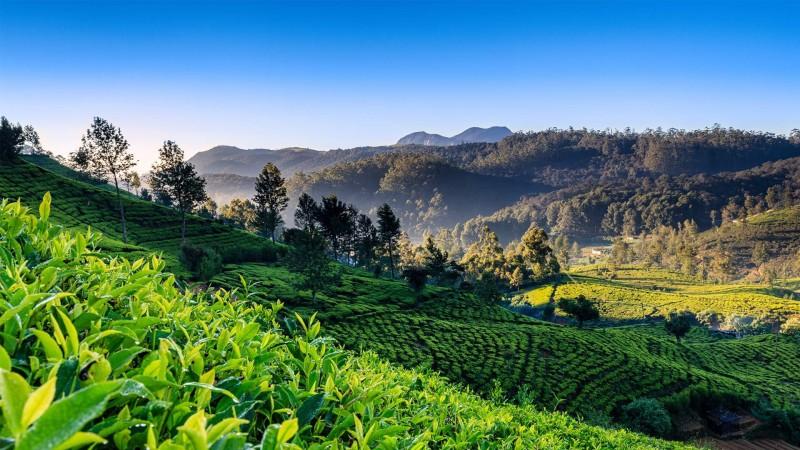
La Naissance d’un Empire du Thé
Alors que l’aube se lève sur Nuwara Eliya, peignant le ciel de nuances roses et dorées, la transformation de cette région en paradis du thé se dévoile. C’est une histoire de résilience et d’innovation qui remonte à la fin du XIXe siècle.
Autrefois, des plantations de café s’étendaient à perte de vue, une mer verte promettant prospérité. Mais la nature en a décidé autrement. Un fléau dévastateur a frappé, anéantissant les récoltes et menaçant les moyens de subsistance. C’est dans ce moment de crise qu’un héros inattendu est apparu : James Taylor, un pionnier écossais dont la vision allait transformer Nuwara Eliya à jamais.
En 1867, sur une modeste parcelle de 19 acres à la plantation de Loolecondera, Taylor a planté les premières graines de thé. Il était loin d’imaginer que ces petites graines déclencheraient une révolution, métamorphosant Nuwara Eliya d’un havre de café en capitale du thé du Sri Lanka. Aujourd’hui, lorsque vous vous tenez dans ces mêmes champs, l’histoire murmure à travers le bruissement des feuilles. L’air est chargé du parfum terreux du thé, une senteur qui imprègne ces collines depuis plus de 150 ans. C’est un lien tangible avec le passé, un rappel de l’ingéniosité et de la persévérance qui ont transformé une crise en opportunité.
Mais l’esprit pionnier de Taylor n’était que le début. Alors que la réputation des conditions idéales de Nuwara Eliya pour la culture du thé – haute altitude, climat frais et sol riche en minéraux – se répandait, de nouvelles plantations ont vu le jour. Le paysage a changé : des rangées bien ordonnées de théiers ont remplacé les plants de café, et des fabriques de style colonial ont commencé à parsemer les collines.
L’un de ces lieux emblématiques est la plantation de thé Pedro, fondée en 1885. Ce vestige vivant de l’âge d’or du thé de Ceylan offre aux visiteurs un aperçu de cette époque révolue. En approchant de la plantation, vous êtes accueilli par une mer de théiers bien taillés, aux feuilles brillantes scintillant sous le soleil. L’usine d’époque coloniale, avec sa façade en briques rouges et ses grandes fenêtres, se dresse comme un témoignage durable de l’héritage industriel du thé à Nuwara Eliya.
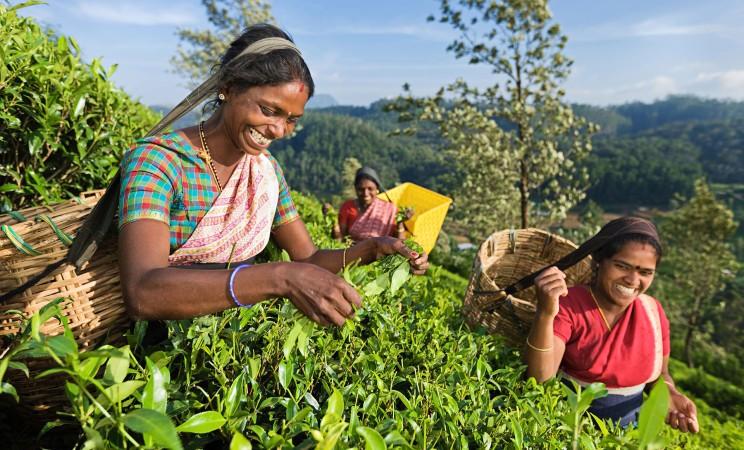
L’Art et la Science de la Fabrication du Thé
Notre voyage nous mène au cœur de la production de thé : la fabrique. Y pénétrer, c'est entrer dans un monde différent. L’atmosphère change, l’air devient chaud et humide, chargé des arômes complexes des feuilles de thé en fermentation. Le bourdonnement rythmique des machines crée une toile sonore apaisante pour cette danse minutieuse de la fabrication du thé. À la fabrique de thé Pedro, l’une des plantations et usines incontournables pour les amateurs de thé, vous assisterez à la transformation de simples feuilles en un élixir aromatique apprécié dans le monde entier. Ce processus est un équilibre délicat entre art et science, tradition et innovation, perfectionné au fil des générations.
Tout commence dans les champs, où des cueilleurs expérimentés démontrent leur savoir-faire. Avec des doigts agiles et des yeux attentifs, ils sélectionnent uniquement les meilleures feuilles – les célèbres « deux feuilles et un bourgeon », signe distinctif du thé de qualité. Ce travail exige des années d’expérience pour maîtriser la vitesse et la précision nécessaires à une récolte optimale. À l’intérieur de la fabrique, la véritable magie opère. Les feuilles sont soigneusement flétries, ce qui réduit leur teneur en humidité et les prépare pour les étapes suivantes. Vient ensuite le roulage, un processus qui libère les huiles essentielles des feuilles et amorce l’oxydation qui donne au thé noir sa saveur unique.
La fermentation suit, une étape cruciale où les feuilles exposées à l’oxygène foncent et développent des arômes complexes. Enfin, les feuilles sont séchées, interrompant l’oxydation et fixant les saveurs qui se libéreront lors de l'infusion.
Chaque étape est essentielle, une chorégraphie minutieuse qui révèle les saveurs et arômes uniques du thé de Nuwara Eliya. Comme l’explique M. Perera, maître de thé de troisième génération et notre guide expert : « Faire du thé, c’est comme composer une symphonie. Chaque note doit être parfaite pour que l’œuvre finale chante. »
Mais l’art de la fabrication du thé à Nuwara Eliya ne consiste pas seulement à suivre un processus établi. C’est aussi comprendre les subtilités de chaque lot de feuilles, adapter les techniques selon les conditions climatiques et viser constamment la perfection. Cette quête de l’excellence distingue le thé de Nuwara Eliya et lui a valu une place parmi les meilleurs thés du monde.
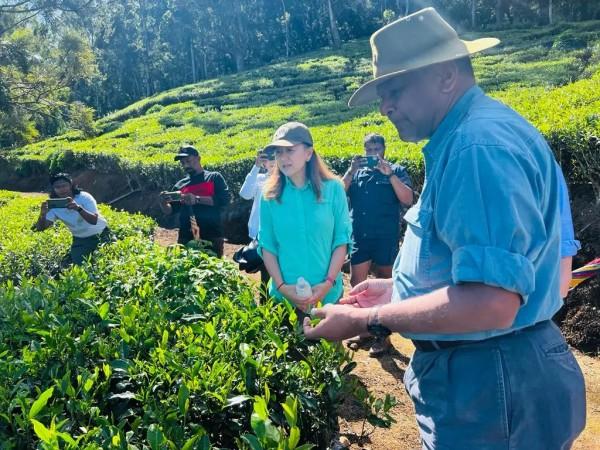
Un Goût de Tradition
Aucun séjour à Nuwara Eliya ne serait complet sans une véritable dégustation de thé. À l’Heritance Tea Factory, un hôtel unique aménagé dans une ancienne usine de thé, vous embarquerez pour un voyage sensoriel qui transformera à jamais votre perception du thé. L’Heritance Tea Factory est un véritable chef-d’œuvre, une conversion ingénieuse du patrimoine industriel en hébergement luxueux. En approchant, sa façade verte et blanche se détache sur le paysage verdoyant, rappelant le passé colonial de la région. À l’intérieur, de nombreux éléments d'origine de l’usine ont été préservés, créant une atmosphère unique où histoire et confort moderne se rencontrent.
Dans le salon de dégustation chaleureux de l’hôtel, entouré d’anciens équipements de fabrication de thé et de photographies d’époque, vous découvrirez l’art de la dégustation. Votre guide, un sommelier de thé certifié, vous fera explorer les subtilités des différentes variétés de thé, du goût intense et corsé de l’Orange Pekoe aux notes florales délicates du thé blanc Silver Tips. En savourant chaque gorgée, vous comprendrez que la dégustation de thé est un art à part entière. Vous apprendrez à apprécier la couleur de l’infusion, à en inhaler l’arôme et à savourer les saveurs complexes qui dansent sur votre palais. Chaque variété raconte une histoire différente – celle du sol, des conditions climatiques, de la culture minutieuse et du savoir-faire artisanal.
Mais le thé à Nuwara Eliya ne se résume pas à une simple boisson ; c’est un symbole culturel. Dans la culture sri-lankaise, offrir du thé est un geste d’hospitalité, une manière d’accueillir les invités et de créer des liens. En participant à cette dégustation, vous ne goûtez pas seulement des saveurs ; vous prenez part à une tradition séculaire qui est au cœur de la vie sociale sri-lankaise.
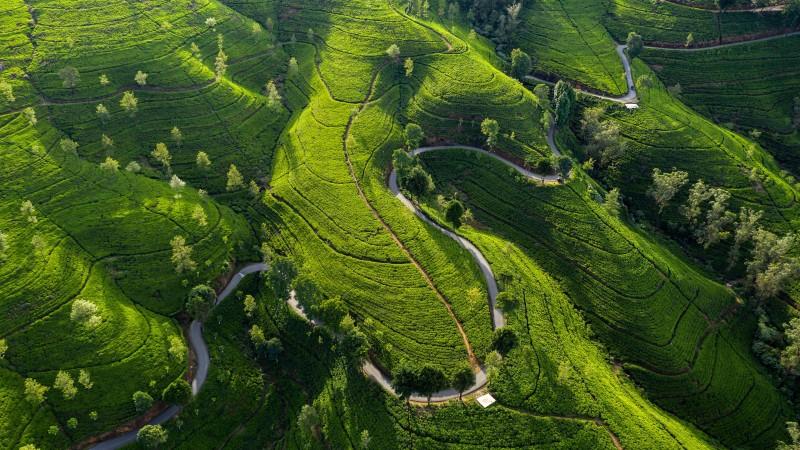
Durabilité : Cultiver l’Avenir
L’industrie du thé à Nuwara Eliya ne se limite pas à préserver la tradition ; elle innove aussi pour bâtir l’avenir. Face aux préoccupations croissantes liées au changement climatique et à l’impact environnemental, de nombreuses plantations de la région sont à la pointe des pratiques durables, servant de modèle à l’agriculture mondiale.
Prenez par exemple la plantation Lovers Leap, nommée d’après la falaise spectaculaire qui surplombe ses terres. Cette plantation est devenue un phare de la production de thé durable. En approchant, vous remarquerez des panneaux solaires scintillant au soleil, alimentant une grande partie des opérations de l’usine. Cette transition vers les énergies renouvelables ne profite pas seulement à l’environnement ; elle permet aussi de réduire les coûts de production, garantissant la viabilité à long terme de l'industrie.
En parcourant le domaine avec Mme Jayawardena, scientifique de l’environnement devenue cultivatrice de thé, vous découvrirez un monde où la technologie moderne et la sagesse ancienne coexistent harmonieusement. Des systèmes de récupération des eaux de pluie permettent de maximiser l’utilisation de chaque goutte précieuse, une adaptation essentielle face aux changements des régimes pluviométriques. Parallèlement, des capteurs de sol sophistiqués optimisent l’utilisation des engrais, réduisant ainsi le ruissellement et protégeant l’écosystème environnant.
Mais la durabilité ici ne se limite pas aux préoccupations environnementales. De nombreuses plantations de Nuwara Eliya, y compris Lovers Leap, sont des pionnières des pratiques de commerce équitable. Ces initiatives garantissent que les avantages de l’industrie du thé sont partagés équitablement avec les travailleurs et les communautés locales. En explorant la plantation, vous pourriez apercevoir de nouvelles habitations pour les travailleurs ou un centre communautaire financé par les primes du commerce équitable.
L’engagement envers la durabilité s’étend également aux champs eux-mêmes. Les méthodes agricoles biologiques sont de plus en plus courantes, protégeant à la fois les théiers et la riche biodiversité de la région. « Nous ne cultivons pas seulement du thé », explique Mme Jayawardena en désignant un oiseau vif voletant entre les buissons. « Nous préservons tout un écosystème. » Cette approche holistique de la durabilité ne profite pas seulement à l’environnement et aux communautés locales ; elle produit aussi certains des meilleurs thés du monde. Les thés biologiques et durables de Nuwara Eliya gagnent en reconnaissance auprès des connaisseurs pour leur saveur exceptionnelle et leur pureté.
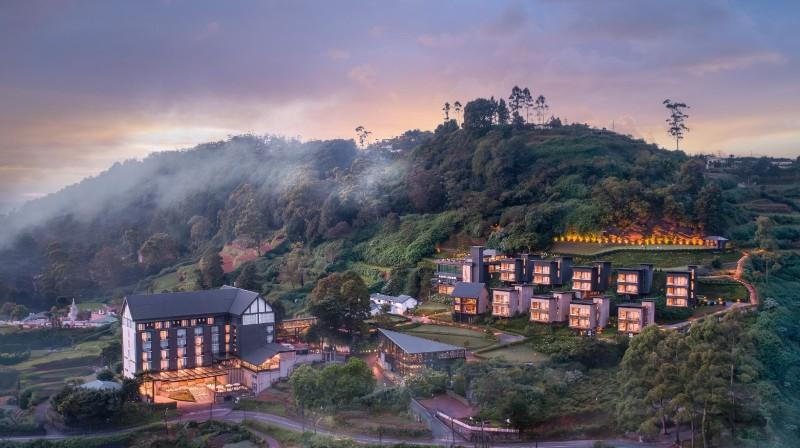
Au-Delà de la Tasse de Thé : Les Trésors Cachés de Nuwara Eliya
Si le thé est incontestablement la vedette de Nuwara Eliya, la région offre bien plus aux voyageurs curieux. Alors que le soleil de l’après-midi commence à décliner, projetant de longues ombres sur les plantations, Tweet Tours vous emmène à la découverte d'autres sites emblématiques, chacun chargé d’histoire et de charme unique.
Une visite au parc Victoria, un jardin magnifiquement entretenu au cœur de la ville, offre une pause paisible après une journée d'exploration. Créé en 1897 pour commémorer le jubilé de diamant de la reine Victoria, le parc est un véritable musée vivant de l’histoire coloniale et de l’art horticole. En vous promenant sur ses sentiers sinueux, vous pourriez apercevoir des oiseaux rares comme le gobemouche du Cachemire ou le rougequeue indien, attirés par la diversité florale du parc.
Pour les plus aventureux, une randonnée à l’aube jusqu’à World's End, dans le parc national de Horton Plains, promet une expérience inoubliable. Classé au patrimoine mondial de l’UNESCO, ce site est un haut lieu de biodiversité, abritant des espèces endémiques que l’on ne trouve nulle part ailleurs sur Terre. World's End est une falaise vertigineuse d’environ 1 200 mètres de haut, offrant une vue imprenable sur les terres du thé en contrebas. Observer le lever du soleil depuis ce point, illuminant les vallées en une palette d’or et de vert, est un moment gravé à jamais dans la mémoire.
Aucune visite à Nuwara Eliya ne serait complète sans un passage par le charmant lac Gregory. Créé en 1873 par le gouverneur William Gregory, le lac était à l’origine destiné à fournir de l’électricité à la ville. Aujourd’hui, c’est un lieu de loisirs prisé où vous pouvez louer un pédalo, pique-niquer sur les rives verdoyantes ou simplement vous asseoir et contempler le jeu de lumière sur l'eau au crépuscule.
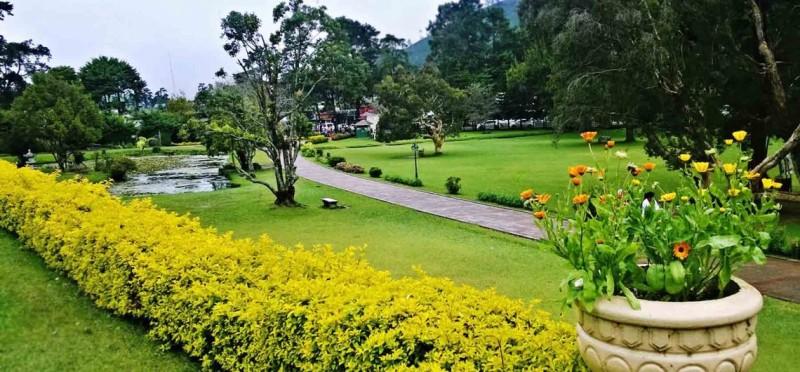
Un Héritage Imprégné de Saveurs
Alors que notre voyage à travers Nuwara Eliya touche à sa fin, nous nous retrouvons là où tout a commencé, savourant une dernière tasse de thé tandis que le soleil se couche derrière les montagnes. Mais désormais, cet acte simple revêt une signification toute nouvelle. Chaque gorgée est une connexion avec la terre, avec les gens qui ont entretenu ces plantations pendant des générations, et avec une tradition qui a façonné l’identité d’une région entière.
L’industrie du thé de Nuwara Eliya est bien plus qu’une simple force économique ; elle fait partie intégrante du patrimoine culturel du Sri Lanka. Elle témoigne de l’ingéniosité humaine, célèbre les bienfaits de la nature et crée un pont entre le passé et l’avenir.
L’histoire du thé de Nuwara Eliya est celle de la résilience, de l’innovation et de l’engagement. Depuis la première parcelle expérimentale de James Taylor jusqu’aux plantations durables et high-tech d’aujourd’hui, l’industrie a évolué sans jamais renier ses racines. C’est une histoire écrite dans les collines verdoyantes, l’architecture coloniale et dans le tissu même de la société locale. En quittant Nuwara Eliya, vous emporterez avec vous non seulement des souvenirs, mais aussi une appréciation plus profonde du monde complexe qui se cache derrière chaque tasse de thé de Ceylan. Vous vous souviendrez des matins brumeux dans les champs de thé, de la chaleur de l’hospitalité sri-lankaise et de la riche palette de saveurs que vous avez découvertes.
Alors, la prochaine fois que vous dégusterez une tasse de thé de Ceylan, prenez un moment pour fermer les yeux et laissez vos souvenirs vagabonder. Dans chaque tasse fumante, vous retrouverez les collines couvertes de brume de Nuwara Eliya, les rires des cueilleurs dans les champs, le bourdonnement des machines dans des usines centenaires et l’esprit d’innovation qui continue de propulser cette industrie remarquable.
Êtes-vous prêt à entreprendre votre propre aventure du thé ? Rejoignez-nous chez Tweet Tours pour un voyage inoubliable au cœur du pays du thé du Sri Lanka. Des expériences pratiques dans les champs de thé aux dégustations luxueuses et au-delà, nous vous aiderons à découvrir la magie qui se cache derrière chaque tasse de thé de Nuwara Eliya. Réservez votre visite aujourd’hui et préparez-vous à vous plonger dans l’histoire, la culture et les saveurs de cette région extraordinaire.
Des articles pour vous

Explore Fukushima - Japan Travel, Asia
Nestled in Japan's scenic Tohoku region, Fukushima offers travelers a unique blend of historical charm, cultural richness, and natural beauty. Known for its stunning landscapes and welcoming communities, Fukushima is an excellent destination for those seeking an authentic Japanese experience beyond the bustling metropolises. Renowned for its diverse attractions, from ancient castles and hot springs to vibrant festivals and picturesque countryside, Fukushima offers a great opportunity for cultural and historical exploration for anyone who loves Japanese culture.
Population: Approximately 1.8 million in 2023.
Economy: Specializing in the seafood and fishing industries, Fukushima, with its historical impacts, now continues to thrive as one of the most developed and largest economies in Japan.
Landmarks: Famous for Aizu-Wakamatsu Castle, Fukushima City Historical Museum, and Ouchi-juku.

La symphonie saisonnière de l'Inde : Révéler les meilleurs moments pour explorer le sous-continent
Les traditions anciennes dansent avec les merveilles modernes dans une terre où les épices et l'encens embaument l'air, et chaque recoin cache une histoire prête à être découverte. L'Inde, vaste et diverse, se déploie comme un monde miniature en soi. Mais quand devriez-vous entreprendre ce voyage épique ? Rejoignez-nous pour un tourbillon à travers la tapisserie saisonnière de l'Inde et trouvez le moment parfait pour votre aventure.

Voyage culinaire à travers la Chine : Savourez les saveurs diversifiées
Des rives subtropicales de Canton aux steppes balayées par le vent du Xinjiang, le vaste paysage de la Chine est une tapisserie de saveurs, chaque région mettant en avant ses propres trésors culinaires. Avec plus de 2000 miles séparant les palais de dim sum du sud des étals de kebabs du nord-ouest, et des woks crépitants entre les deux, la diversité gastronomique de la Chine est véritablement inégalée. Alors, prenez vos baguettes et embarquez pour une aventure gourmande à travers les plats les plus délicieux du Royaume du Milieu !

Vivez l'expérience à bord du RV Indochine II - Une croisière sur le Mékong
Le RV Indochine II est un navire de croisière fluviale de luxe, offrant un voyage inoubliable à travers de nombreuses attractions le long du fleuve Mékong. Construit en 2017, ce vaisseau haut de gamme allie élégance coloniale et commodités modernes pour créer un environnement à la fois confortable et élégant pour son équipage et ses passagers. La taille intime du navire en fait le choix idéal pour ceux qui recherchent une expérience de croisière plus personnelle tout en explorant la culture, les paysages et le patrimoine riches du Vietnam et du Cambodge. Que vous admiriez le paysage depuis votre balcon privé ou que vous dégustiez une cuisine locale authentique, le RV Indochine II promet une aventure exotique hors du commun.

Assistez à la pêche sur pilotis au Sri Lanka
Le Sri Lanka, réputé pour ses plages magnifiques et son riche patrimoine culturel, abrite une tradition unique qui captive les voyageurs depuis des siècles : la pêche sur pilotis. Cette pratique ancienne, transmise de génération en génération au sein des communautés côtières, allie art et nécessité, offrant un aperçu d'un mode de vie intimement lié aux rythmes côtiers de l'île. La pêche sur pilotis au Sri Lanka n'est pas simplement un moyen de capturer des poissons ; c'est un emblème culturel, incarnant la résilience et l'ingéniosité des communautés de pêcheurs sri-lankaises.

À l'assaut des sommets : guide du randonneur de l'Himalaya
Lorsque les premiers rayons du soleil teintent les sommets enneigés de doré et de rose, vous êtes au seuil de l'aventure. Bienvenue dans l'Himalaya, où chaque pas est une immersion dans le plus grand spectacle de la nature. Avec Tweet World Travel comme guide, préparez-vous à un trek d’aventures, qui éveillera vos sens et vous transformera à jamais.
